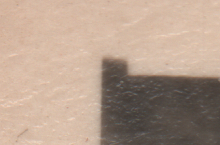I don’t think I have ever seen this artifact, what follows is a guess. You should know that I am 85 years old and more than 60 of those years was in the photofinishing profession. At the apex of my photofinishing career, I designed and presided over 7 high speed labs. Each sized to process and print 20,000 rolls of film a day.
As the photofinishing business evolved, starting at the turn of the last century, many schemes were used to automate the various procedures. A major problem was cutting the film into packageable strips and cutting the roll paper prints apart with accuracy.
The films, both black & white & color, were machine developed and then sent to a printing station. These printers were loaded with a giant roll of photo paper. Each negative was individually custom printed. After a time, the entire roll of paper was sent to be developed in an automated paper processing machine.
The developed paper roll, containing hundreds of orders, likely 8 or 12 or 20 prints per order was then inspected and each print substandard print was marked with wax pencil whether to be trashed or reprinted with corrections. This roll of paper went to an assembly station. The negatives and prints were matched up and the negatives were cut in strips and the print cut apart for packaging.
As the procedures became more and more automated, many schemes were employed to automate this assembly process. Not easy because often the film images overlapped or were missing plus irregular distances between frames.
At first the negative and print cutting was a manual operation. After a time, the negatives were notched to locate the appropriate place to cut them into strips. The printers used ink or pencil and placed marks on the back of the roll paper.
This mark is probably made by a lamp inside the printer. At the time for print exposure, this lamp exposed and an index maker at the margin of the print. Later an automatic cutter will use this mark to accurately position a guillotine knife so that it cuts the roll of paper prints precisely at the junctions between the prints.





